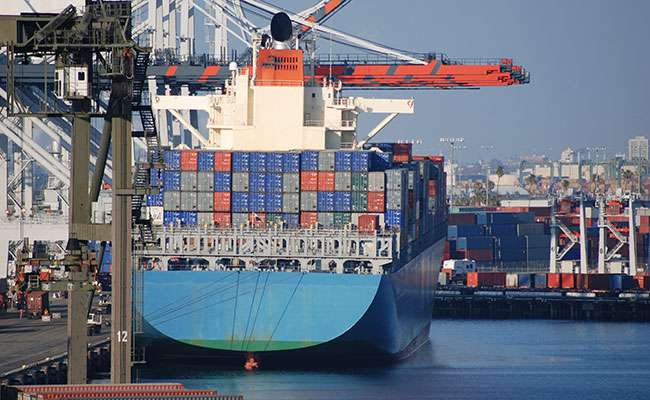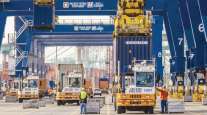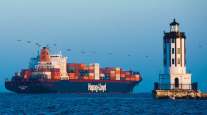Senior Reporter
Nation’s Ports Have Historic Year, and No Slowdown Expected

[Stay on top of transportation news: Get TTNews in your inbox.]
It is unlikely that in the long history of the Port of Los Angeles and its adjacent partner, the Port of Long Beach, have those facilities and others across the nation received as much news coverage as in 2021 because of the supply chain crisis.
As the COVID-19 pandemic raged in 2020, cargo container volumes at the nation’s seaports plunged at some facilities to 2017 levels, only to snap back to record highs just six months later as the U.S. economy recovered from the short but deep recession.
Earlier in the pandemic and to a slightly lesser extent today, consumers dramatically shifted from paying for services, such as airline tickets, hotel rooms and entertainment, to buying truck-transported goods, including refrigerators, home office furniture and computers.

- ECONOMY: Economy Stays Resilient During Pandemic
- EQUIPMENT: Equipment Segment Marched to Higher Ground in 2021
- GOVERNMENT: Year of the $1 Trillion Infrastructure Law
- ACQUISTIONS: Trucking Industry M&A Activity Surges During 2021
- DRIVERS: Driver Shortage Defines Trucking for 2021
On the East and West Coast and at ports along the Gulf of Mexico, container volumes have skyrocketed.
Through October, the Port of Los Angeles was running 22% ahead of 2020’s container total and is on track to easily surpass 10 million. The port’s record is 9.4 million 20-foot-equivalent units in 2018.
In Georgia, the rapidly growing Port of Savannah is set to surpass 5 million in 2021, with the release of the November numbers later this month. The port could even top 5.5 million units depending on the strength of the holiday shopping season. Savannah’s all-time record was set in 2019, when workers processed 4.68 million units.

Costello
“Retail sales are up just under 20% year-over-year. And in October, it was up 16% year-over-year,” American Trucking Associations Chief Economist Bob Costello said. “Strong numbers from both retail stores and online shopping simply means that households are spending money in a lot of different areas.”
Now, a year into the economic recovery and resulting disruptions, officials believe the worst of this may be over, but they stress the supply chain will look significantly different in 2022 and beyond than it did in February 2020, when only a handful of people knew about COVID-19.

Butler
“If I had to sum it up, I’d say the supply chain is saturated,” World Shipping Council President John Butler told Transport Topics. “It’s not just a U.S. phenomenon; it’s a global phenomenon. Everywhere you look, you see ships waiting to get into ports to unload their goods and then load exports. We see congestion inland, shortages of truck drivers and full warehouses almost everywhere.”
To affirm Butler’s point, commercial real estate company CBRE says the national warehouse vacancy rate in the third quarter was a record-low 3.6%. Near Los Angeles and Long Beach, it was 1%, compared with 2.3% in 2020.

Connor
“The consequences of decadeslong underinvestment in maritime infrastructure are playing out in real time in the form of supply chain disruptions and delays that have been exacerbated by the pandemic,” said Chris Connor, CEO of the American Association of Port Authorities.
In late October, the two ports proposed instituting a series of progressively increasing fees directed at the shipping community to encourage the removal of the tens of thousands of empty containers. Those fees have been put on hold several times as officials say the number has dropped by nearly 40%.
“Things are getting better, but there is a lot of work ahead to be done,” Port of Long Beach Executive Director Mario Cordero told TT. “We’re making progress and moving the cargo.”
Cordero’s counterpart at the Port of Los Angeles agreed.
San Pedro Bay is looking less crowded these days. The fleet of container ships loitering just offshore has thinned to 46 boats from its peak of more than 80.
Is that a good sign for Southern California’s supply chain? It depends on who you ask. https://t.co/fwHPqZ83Cp — Los Angeles Times (@latimes) December 3, 2021
“In recent weeks, clearing our docks of imports and empties has been a top priority,” Executive Director Gene Seroka said. “As a result, we’ve seen a marked improvement of fluidity on our marine terminals, which allows more vessels to be processed.”
While ports on both coasts are congested, the local port authorities that run those facilities have been spending hundreds of millions in recent years to upgrade their shipping channels, add cranes and improve rail and truck freight access. The new $1.2 trillion infrastructure law also will bring additional money, with an investment of at least $17 billion earmarked for ports.
Crane 52 is being raised in the work area today at Wando Welch Terminal. This is 1 of 2 new ship-to-shore cranes. With the addition of the two, #SCPorts will have 15 STS cranes offering 155 ft of lift height at Wando Welch Terminal. pic.twitter.com/5zMaaMQ9Yp — South Carolina Ports (@SCPorts) December 3, 2021
Most of the nation’s top 15 ports have undertaken expansion projects. South Carolina’s Port of Charleston, the Port of Baltimore, Georgia’s Port of Savannah, Port Houston and the Port Authority of New York and New Jersey are a few facilities that had started significant upgrades even before the pandemic caused imported products to spike on both coasts.
Even with the anticipated container record in Savannah, port officials say that because of recent expansion the facility could process as many as 7 million containers a year by 2023.
Want more news? Listen to today's daily briefing below or go here for more info:




